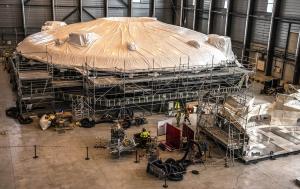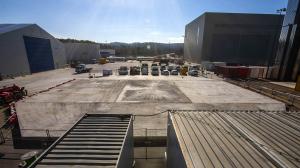Wrap it tight and let it rest
Wrapping can be a mere necessity, often a chore and sometimes an art. At ITER, the act of wrapping is an industrial-size operation that requires dozens of operators, sophisticated equipment and tonnes of material. Whether manufactured abroad or on site, components need to be protected in order to withstand the hardships of a long journey and/or long-term storage prior to their installation in the tokamak assembly pit.
There are several efficient techniques for sealing away large components. In April 2019, the cryostat upper cylinder was tightly wrapped in layers of synthetic thermoplastic material and placed into an air-tight, atmosphere-controlled cocoon.
The cocooning process, however, uses certain chemical products whose quantity on any given worksite is strictly regulated in France. Once the 10-metre-tall, 30-metre-in-diameter component was wrapped and sealed, the regulatory limit had nearly been reached and would have been largely passed if the same process had been used for the cryostat top lid. Protecting this component for long-term storage required a different solution.
Contrary to the cocoon, whose elements were partly produced on site for the upper cylinder, the different layers of plastic wrapping used for the top lid are delivered "ready to use" and do not require the handling of regulated chemicals.
"The process chosen, called VCI packing (for "volatile corrosion inhibitor") is equivalent, in terms of leak-tightness and protection, to the cocooning," explains Guillaume Vitupier, the leader of the ITER Cryostat Group.
Wrapping operations began one month ago, close to one year after the massive component (665 tonnes) was finalized. Before the first layer of VCI was installed, three cameras were positioned in strategic locations inside to monitor the component's surface. To the tightly adhering first layer, a second wrapping was added and heated by blowtorch in order to fit to the component's shape as closely as possible. Operations are now in their final stages as a thick and heavy external cover (1.5 tonnes) made of approximately 50 made-to-measure sections is being installed.
Like fragrance diffusers in a room, capsules inside the packing "will saturate the atmosphere with corrosion inhibitor molecules," says Vitupier. "Molecule concentration as well as humidity will be monitored at all time."
As its name suggests, the cryostat top lid will "close" the giant vacuum chamber that surrounds the ITER tokamak at the end of core machine assembly. In the meantime, in early April this massive component—the second heaviest single component of the machine¹—will be moved out of the Cryostat Workshop where it was assembled and welded and placed in outdoor storage across the road near the Cleaning Facility. A 50-centimetre-thick reinforced slab was recently created to withstand the combined weight of the component and its support frame, which approaches 1,000 tonnes.
¹ At 1,250 tonnes, the cryostat base, which was installed in the tokamak assembly pit in May 2020, is the heaviest single machine component.



